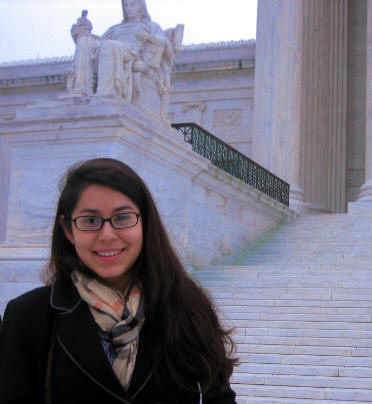
Vasquez v. United States
Political Science Student Attends Oral Arguments at Supreme Court

On March 21st, 2012, Ana observed Chief Justice John Roberts and the 8 Associate Justices hear the case Vasquez v. United States. Details of the case are below.

On August 5, 2008, Joel Perez and Carlos Cruz drove to a Shell station in Arlington Heights, Illinois, with Cruz at the wheel. They met with Alejandro Diaz, who was working with Drug Enforcement Agency officials. He instructed them to meet him at a different location to complete the deal. Perez walked to a nearby Denny’s, where Alexander Vasquez waited for him in the driver’s seat of a black Pontiac Bonneville. Perez got into the passenger seat of the Bonneville and called Cruz, telling him that he was not willing to follow Diaz. Cruz then walked to the Denny’s, where he was introduced to Vasquez.
Diaz contacted his DEA handler. Law enforcement agents then surrounded the parking lot in their vehicles; several officers approached the Bonneville to arrest Vasquez, Cruz, and Perez. Cruz, outside the car, raised his hands in surrender. Vasquez, however, attempted to escape in the Bonneville, with Perez still inside. Police found the Bonneville abandoned in a Walmart parking lot, and a short time later apprehended Vasquez and Perez. They found $23,000 stashed in a secret compartment in the Bonneville. A federal grand jury indicted Vasquez on conspiring to possess with intent to distribute more than 500 grams of cocaine and on attempting to possess with intent to distribute more than 500 grams of cocaine.
At trial, Vasquez called Perez’s wife Marina as a witness to testify. Marina Perez testified that she called Vasquez before the events in question to ask him to pick up Joel Perez at the Denny’s, implying that Vasquez was there by coincidence. In response, the government introduced transcripts and audio recordings of conversations between Marina Perez and her husband as evidence of bias. This evidence indicated that Marina Perez spoke to her husband about a possible plea deal; she also mentioned that Vasquez’s attorney told her, “everybody is going to lose.” The trial judge allowed these transcripts and recordings to be admitted to show Marina Perez’s bias and for the truth of their contents. The jury found Vasquez guilty on the charge of conspiracy but not guilty on the charge of attempting to possess cocaine.
In a split decision, the U.S. Court of Appeals for the Seventh Circuit held that evidence of conversations between Marina Perez and her husband were properly admitted to show bias and inconsistency with prior statements.
1. Did the court apply the correct test in determining that the introduction of conversations between Marina Perez and Vasquez’s counsel into evidence was harmless error?
2. Did this error violate Vasquez’s Sixth Amendment right to a trial by jury?